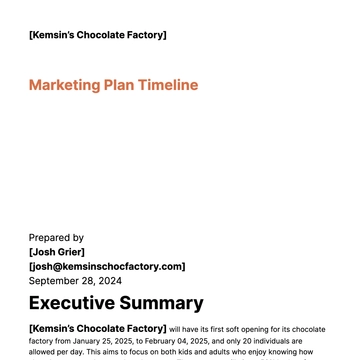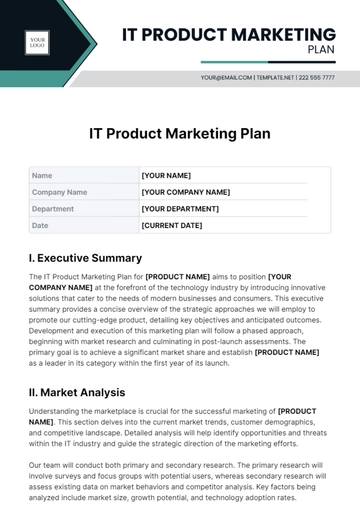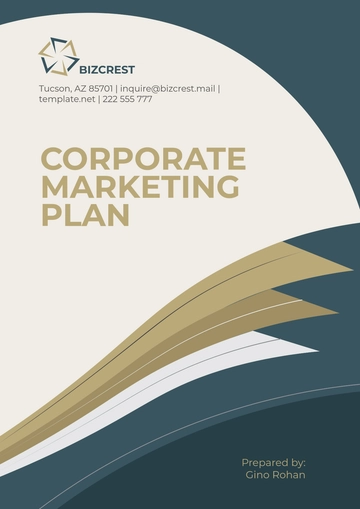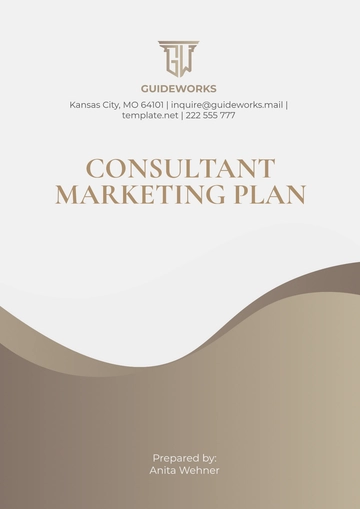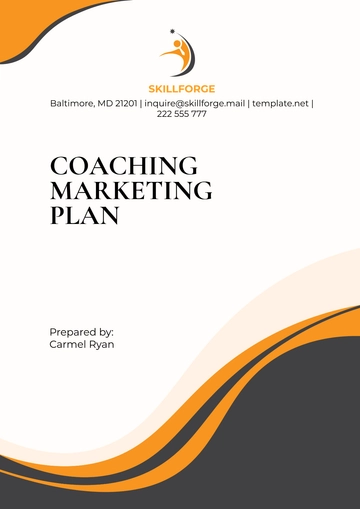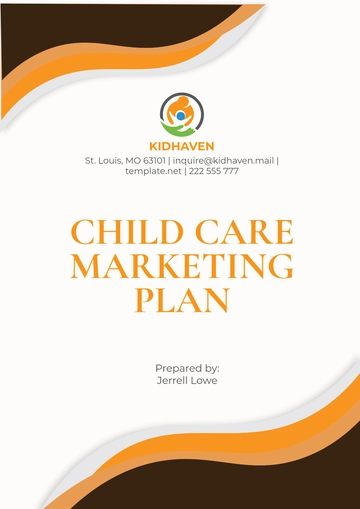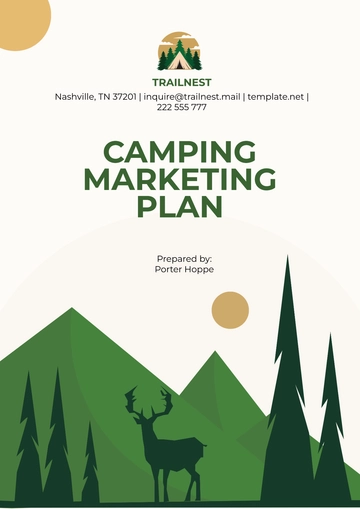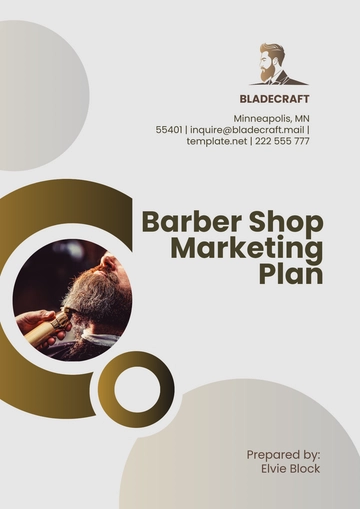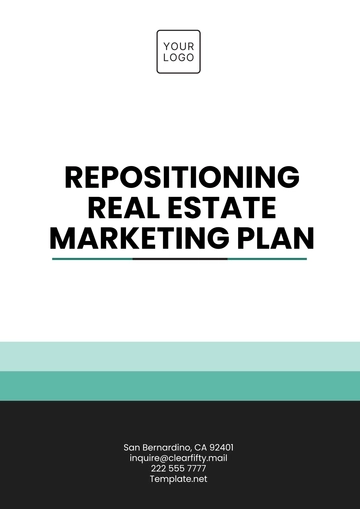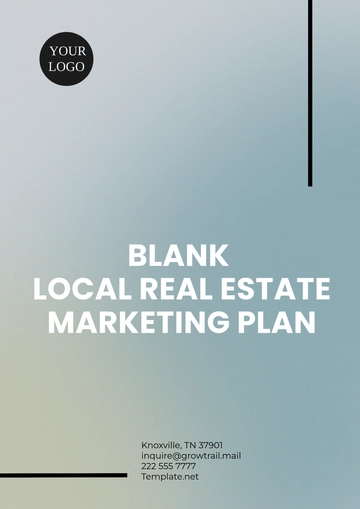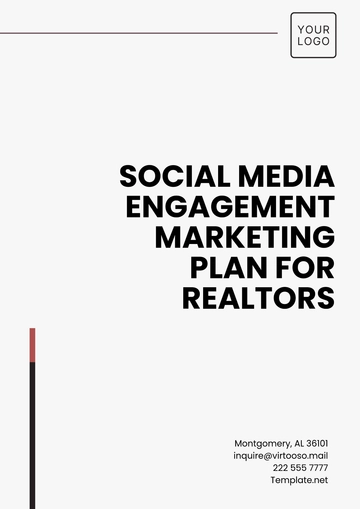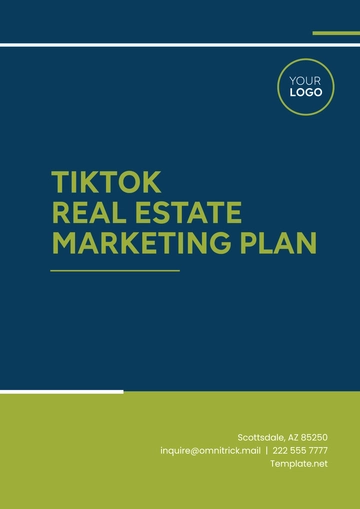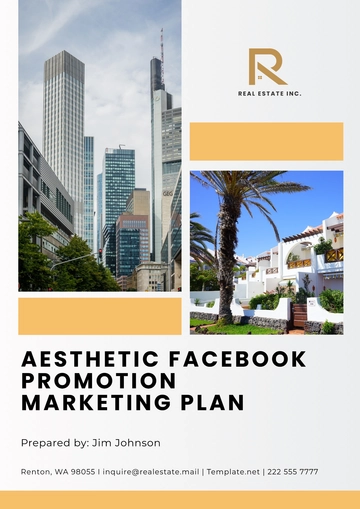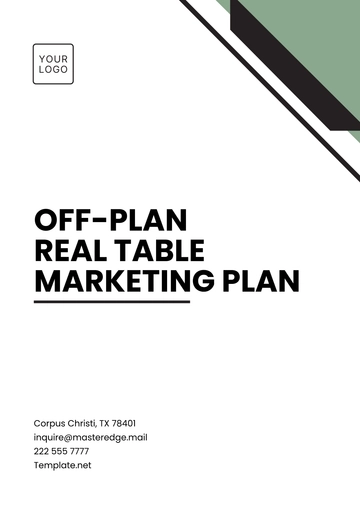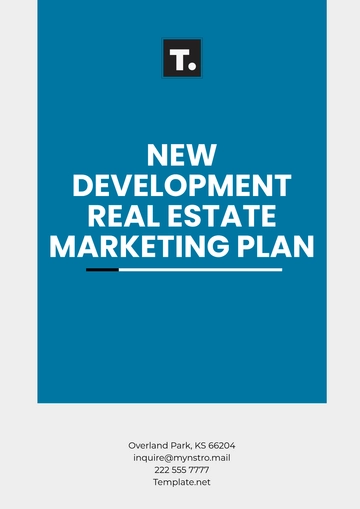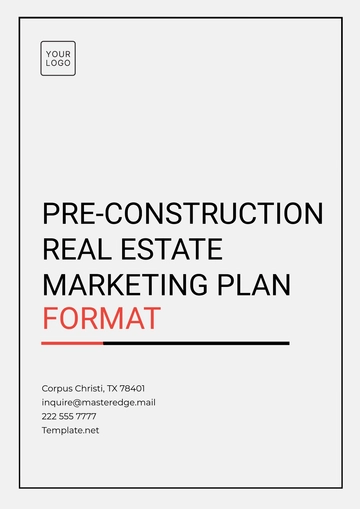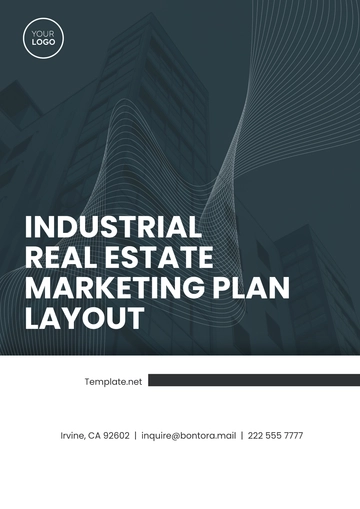Free Catering Marketing Plan

I. Executive Summary
A. Purpose of the Plan
The Catering Marketing Plan for [Your Company Name] is designed to outline the company's approach to achieving sustainable growth and becoming a leading provider in the competitive catering industry. As of the year [2050], the catering industry is rapidly evolving, driven by changing consumer preferences, advances in technology, and increased demand for personalized, health-conscious, and sustainable services. This plan will not only guide [Your Company Name] toward capitalizing on these trends but also ensure that it meets its financial and operational targets efficiently.
The purpose of this plan is to align all facets of the business—marketing, operations, finances, and human resources—with the company’s strategic objectives. A comprehensive approach will be taken to explore market opportunities, streamline operations, and foster a brand that resonates with both corporate and individual clients. By integrating these elements into a single cohesive strategy, [Your Company Name] can build a solid foundation for long-term success.
B. Vision and Mission Statement
Vision Statement: By [2055], [Your Company Name] will be the foremost catering company in [Your Region], recognized for providing innovative and unforgettable culinary experiences. We envision a business that not only meets the expectations of our clients but elevates their events through exceptional service, attention to detail, and a deep commitment to sustainable, locally-sourced food.
Mission Statement: [Your Company Name] is dedicated to delivering top-tier catering services that blend high-quality cuisine with exceptional customer service. Our mission is to bring creativity, passion, and professionalism to every event we cater. By leveraging our deep knowledge of food trends and our commitment to sustainability, we seek to create memorable dining experiences that cater to the diverse needs of our corporate and individual clients while fostering strong community relationships.
C. Goals and Objectives
The primary goals of this plan are to grow market share, increase profitability, and establish [Your Company Name] as a trusted brand within the catering industry. Specific objectives include:
Increase Brand Awareness: Within the first [two years] of executing this marketing plan, the aim is to increase brand awareness by [25%], ensuring that [Your Company Name] becomes a recognizable name in both corporate and social event catering.
Expand Client Base: The goal is to attract [500 new clients] by the year [2052], utilizing a combination of digital marketing, strategic partnerships, and targeted promotions. This includes expanding into new geographical regions to tap into a wider audience.
Revenue Growth: The target is to grow annual revenue by at least [20%] year-on-year, starting in [2051]. This growth will be driven by an expanded service offering, increased market share, and effective pricing strategies.
Customer Retention and Loyalty: Another key objective is to increase repeat business by [30%] through enhanced customer relationship management and loyalty programs by [2053]. Satisfied clients will become brand advocates, bringing in referrals and reducing client acquisition costs.
II. Market Analysis
A. Industry Overview
The global catering industry is experiencing robust growth, driven by the increasing demand for both corporate and social event catering. In [2050], the catering industry is projected to be worth approximately [$80 billion], reflecting a strong CAGR of [5%]. The industry is evolving, with more companies focusing on health-conscious, sustainable, and personalized services to cater to diverse client preferences. Technology is also playing a critical role in the transformation of the sector, with advancements in online ordering, event management software, and AI-driven menu personalization tools helping businesses streamline operations and improve customer experiences.
The demand for corporate catering services remains strong, with businesses continually seeking catering for events, employee appreciation functions, product launches, and meetings. In parallel, social event catering, including weddings, family reunions, and birthday parties, continues to be a large revenue driver, with clients looking for customizable, theme-specific offerings that enhance their special occasions.
The catering industry has also witnessed a significant shift toward sustainability. Clients are increasingly demanding eco-friendly practices such as zero-waste policies, locally-sourced ingredients, and biodegradable packaging. Companies that align with these values are better positioned to attract environmentally-conscious clients.
B. Target Market Identification
Identifying and understanding the target market is critical to tailoring [Your Company Name]'s services and marketing strategies to meet the needs of potential clients. Based on market research, the target market is segmented into the following groups:
Corporate Clients: This segment includes businesses that require catering services for events such as company meetings, conferences, employee appreciation days, product launches, and client luncheons. Corporate clients are typically looking for efficiency, reliability, and professional service. High-quality presentation, diverse menu options, and on-time delivery are important factors in this segment. [Your Company Name] will aim to become the preferred catering provider for corporate events in the local and regional markets.
Social Event Clients: Individuals planning weddings, anniversaries, family reunions, birthday parties, and other personal gatherings fall into this category. Social event clients tend to prioritize unique menu offerings, personalized service, and creativity in food presentation. Customized catering packages that align with event themes, dietary preferences, and budgets will be key to winning over this segment.
Non-Profit and Community Organizations: This group includes charities, churches, schools, and other community groups that require catering for fundraising galas, banquets, and social gatherings. Non-profit organizations often seek value-driven services that align with their goals of community engagement and sustainability. [Your Company Name] will develop relationships with these organizations by offering discounted packages and promoting a shared commitment to social responsibility.
Educational Institutions: Schools, colleges, and universities are increasingly hosting events like graduations, alumni gatherings, and faculty meetings, requiring reliable catering services. This market is often budget-conscious and focused on providing nutritious meals for students and staff. By offering balanced and health-conscious meal options, [Your Company Name] can meet the needs of this segment.
C. Competitor Analysis
Conducting a competitor analysis will help [Your Company Name] identify opportunities to differentiate its services and capitalize on competitors' weaknesses. The catering market is competitive, with several established players offering a wide range of services. Key competitors in the region include:
Competitor Name | Service Specialization | Strengths | Weaknesses |
|---|---|---|---|
Competitor A | Full-service event catering | Strong brand recognition, extensive menu options | High pricing, limited flexibility in customization |
Competitor B | Corporate catering services | Well-established corporate relationships | Lack of event-specific customization |
Competitor C | Wedding and event catering | Unique themes, creative presentations | Limited capacity for large-scale events |
Competitor D | Drop-off catering | Affordable and efficient service | Limited menu variety, less personalized service |
By understanding competitor pricing, services, strengths, and weaknesses, [Your Company Name] can strategically position itself as a unique player in the market. For instance, while Competitor A may dominate in brand recognition, [Your Company Name] can compete by offering more personalized and flexible service packages.
D. Market Trends
Identifying and leveraging key market trends will be critical for [Your Company Name] to maintain its competitive edge. Current trends include:
Sustainability and Eco-friendly Practices: The demand for sustainable practices continues to grow, with clients prioritizing caterers who offer locally-sourced, organic ingredients and environmentally-friendly packaging. [Your Company Name] will respond to this trend by partnering with local farmers and suppliers to ensure that ingredients are fresh, local, and sustainable. Additionally, the company will implement eco-friendly practices such as using biodegradable utensils and composting food waste.
Personalization and Customization: Clients increasingly expect catering services to reflect their personal preferences, dietary requirements, and event themes. This trend is particularly strong in the social event sector, where customized menu offerings, themed presentations, and unique dining experiences are highly valued. [Your Company Name] will offer tailored menus that cater to specific dietary needs, such as vegan, gluten-free, or allergen-free options, ensuring that all guests are satisfied.
Health-conscious Options: The catering industry has seen a shift towards healthier menu options, as clients are more focused on wellness and nutrition. This is especially true for corporate and educational institution clients, who often request balanced, nutritious meals. [Your Company Name] will incorporate health-conscious options into all menus, offering low-calorie, nutrient-dense meals that cater to health-conscious consumers.
Technology Integration: With advances in technology, caterers are now able to streamline operations and improve the customer experience. Online ordering systems, customer management software, and AI-driven menu customization are becoming standard practices in the industry. [Your Company Name] will leverage technology to improve efficiency, such as offering an intuitive online ordering platform where clients can easily customize their catering packages and track their orders in real-time.
III. Marketing Strategy
A well-defined marketing strategy is crucial for [Your Company Name] to reach its target audience and establish a strong market presence. The marketing strategy will encompass several components, including branding, product and service offerings, pricing, promotions, and distribution. Each element will be designed to align with the overall goals of the company and to foster long-term growth.
A. Branding Strategy
The branding strategy for [Your Company Name] will focus on creating a unique and memorable identity that resonates with both corporate and social event clients. The brand will reflect core values such as quality, professionalism, sustainability, and creativity.
Brand Identity: The company's visual identity, including the logo, color scheme, and typography, will be designed to evoke feelings of elegance, reliability, and warmth. The branding will communicate that [Your Company Name] is a premium service provider while also being approachable and customer-focused. All marketing materials, including business cards, menus, and digital assets, will maintain a consistent visual identity to reinforce brand recognition.
Brand Voice: The tone of communication in all marketing channels, including social media, email marketing, and website content, will be professional yet friendly. The brand voice will emphasize [Your Company Name]'s commitment to customer satisfaction, attention to detail, and passion for creating extraordinary dining experiences.
Storytelling: Storytelling will be a key component of the branding strategy. [Your Company Name] will highlight its journey, from its commitment to using locally-sourced, sustainable ingredients to its vision of delivering unforgettable events. Personal stories of the team, client testimonials, and behind-the-scenes looks at how menus are crafted will help build an emotional connection with clients and set the company apart from competitors.
B. Product and Service Offering
[Your Company Name] will offer a wide range of catering services that appeal to both corporate and social clients. The product and service offering will include:
Full-Service Event Catering: For large corporate events, weddings, and other social gatherings, [Your Company Name] will provide full-service catering. This includes menu consultation, food preparation, on-site cooking (where applicable), wait staff service, and post-event cleanup. Each event will be fully customized to meet the specific needs and preferences of the client, from dietary restrictions to cultural considerations.
Corporate Catering Packages: Pre-designed packages tailored for corporate clients will be available, including breakfast meetings, lunches, coffee breaks, and executive dinners. These packages will be designed for convenience and quick service, while maintaining high quality and presentation standards.
Drop-off Catering: For smaller events or clients looking for more budget-friendly options, [Your Company Name] will offer drop-off catering services. This service will include a variety of menu options, from boxed lunches to buffet-style platters, delivered directly to the event location without the need for on-site staff.
Specialty Menus: Customization will be a key differentiator for [Your Company Name]. Specialty menus, including vegan, gluten-free, keto, and allergen-free options, will be offered to cater to diverse dietary needs. The company will also develop themed menus for specific events, such as holiday parties, cultural celebrations, and seasonal occasions.
Beverage Service: In addition to food catering, [Your Company Name] will offer a range of beverage services, including non-alcoholic beverages, coffee and tea service, and alcohol packages (where permitted). Partnerships with local wineries and breweries will help elevate the beverage offerings, giving clients a unique selection of locally-sourced options.
C. Pricing Strategy
Pricing will be carefully structured to ensure that [Your Company Name] remains competitive while also reflecting the premium nature of its services. The pricing strategy will include:
Competitive Pricing: A thorough analysis of competitor pricing will be conducted to ensure that [Your Company Name] is positioned competitively. While the company will offer premium services, the pricing will remain accessible to a wide range of clients, from corporate event planners with larger budgets to individuals seeking affordable catering for private events.
Tiered Packages: [Your Company Name] will offer tiered pricing packages to cater to different client segments. For example, basic, mid-tier, and premium packages will be available, allowing clients to choose the level of service that fits their needs and budgets. Each package will clearly outline what is included, such as the number of courses, service staff, and any additional features like décor or table settings.
Custom Quotes: For clients with specific requirements or larger events, custom pricing will be offered based on the complexity and scale of the event. [Your Company Name] will work with each client to create a tailored catering package that fits their vision and budget.
Value-Added Services: To justify premium pricing, [Your Company Name] will include value-added services such as complimentary tastings, personalized consultations, and post-event feedback sessions. These additional services will enhance the client experience and foster long-term relationships.
D. Promotion Strategy
The promotion strategy will focus on building brand awareness, generating leads, and converting prospects into loyal customers. Key promotional tactics will include:
Digital Marketing: [Your Company Name] will invest in a comprehensive digital marketing campaign, including search engine optimization (SEO), pay-per-click (PPC) advertising, and social media marketing. A strong online presence will be crucial for reaching corporate clients and individual event planners.
SEO: The company's website will be optimized for search engines to rank highly for relevant keywords such as "corporate catering in [City]" or "wedding caterers in [City]." Blog posts, event case studies, and customer testimonials will be regularly updated to keep content fresh and improve organic search rankings.
PPC Advertising: Paid advertising on platforms like Google and social media will help drive traffic to [Your Company Name]'s website. Targeted ads will be used to reach specific audience segments, such as corporate event planners or couples searching for wedding services.
Social Media Engagement: [Your Company Name] will maintain active profiles on key social media platforms such as Instagram, Facebook, and LinkedIn. These platforms will be used to showcase the company's work, engage with clients, and promote special offers. Instagram, in particular, will serve as a visual portfolio, where images of beautifully catered events can be shared to attract potential clients.
Email Marketing: Email newsletters will be sent out on a regular basis to keep current and potential clients informed about new services, promotions, and company updates. Special discounts or referral incentives can be offered through these newsletters to encourage repeat business and word-of-mouth marketing.
Event Participation: [Your Company Name] will actively participate in local food festivals, bridal shows, and corporate networking events. These events provide a platform to showcase catering services, offer tastings, and engage directly with potential clients. Sponsorship opportunities at high-profile events can also raise brand visibility.
Referral Programs: A referral program will be introduced, offering existing clients incentives such as discounts or free services for referring new business. Word-of-mouth marketing will be a key driver of growth, particularly in the corporate catering sector, where decision-makers often rely on personal recommendations.
E. Distribution Strategy
The distribution strategy will focus on how [Your Company Name] delivers its services to clients. This includes both the logistical aspects of food delivery and ensuring an exceptional customer experience from start to finish.
Direct Client Service: For full-service events, [Your Company Name] will manage every aspect of the catering process, from menu design to food preparation and event execution. The company will employ a team of trained service staff who will ensure that all food is served professionally and efficiently during the event.
Drop-off Catering: For smaller events or budget-conscious clients, drop-off catering will be available. Food will be prepared and delivered directly to the event venue with clear instructions for setup. This option provides clients with high-quality food without the need for on-site service staff.
Online Ordering Platform: [Your Company Name] will develop an intuitive online platform where clients can easily browse menus, customize their orders, and select delivery options. This system will simplify the ordering process, particularly for repeat corporate clients who require quick and efficient service.
IV. Operational Plan
The operational plan outlines how [Your Company Name] will manage its day-to-day activities, from staffing to logistics. A well-executed operational plan ensures that the company can consistently deliver high-quality service while scaling its operations as demand grows.
A. Staffing Requirements
[Your Company Name] will employ a dedicated team of professionals to ensure smooth operations. The staffing plan will include:
Management Team: The management team will oversee all aspects of the business, including marketing, operations, finance, and customer relations. The key roles in the management team will include a General Manager, Marketing Manager, and Operations Manager. This team will be responsible for strategic decision-making, business development, and ensuring the overall success of the company.
Chefs and Kitchen Staff: The heart of any catering company is its kitchen staff. [Your Company Name] will employ experienced chefs who specialize in different cuisines, allowing the company to offer a diverse range of menu options. Sous chefs, prep cooks, and dishwashers will assist the head chefs in preparing and delivering meals efficiently.
Service Staff: For full-service events, [Your Company Name] will employ a team of servers, bartenders, and event coordinators who will manage the guest experience. These staff members will be trained to provide professional and courteous service, ensuring that every event runs smoothly.
Delivery Staff: For drop-off catering, dedicated delivery drivers will ensure that food is transported safely and delivered on time. All delivery staff will be trained in proper food handling and customer service to maintain high standards.
Event Coordinators: Event coordinators will work directly with clients to understand their vision and needs, manage logistics, and ensure that all aspects of the event are executed seamlessly. They will serve as the primary point of contact for clients, coordinating with chefs, service staff, and suppliers to create a cohesive and enjoyable experience for guests.
B. Equipment and Supply Needs
To operate efficiently, [Your Company Name] will require a range of equipment and supplies. These will be divided into three main categories: kitchen equipment, transportation vehicles, and serving supplies.
Kitchen Equipment: A fully equipped commercial kitchen is vital for food preparation. Essential equipment will include:
Cooking Appliances: Ovens, stoves, grills, and fryers, specifically designed for large-scale food production.
Food Prep Equipment: Slicers, mixers, food processors, and other tools needed for efficient meal preparation.
Storage Solutions: Commercial refrigerators, freezers, and dry storage spaces to maintain food safety and quality.
Dishwashing Equipment: Industrial dishwashers to streamline cleanup and maintain hygiene standards.
Transportation Vehicles: Reliable vehicles are necessary for transporting food to events. The plan includes:
Delivery Vans: Refrigerated vans to keep perishable items fresh during transit.
Service Vehicles: Trucks that can transport larger equipment and supplies for full-service events, ensuring that everything needed is on-site.
Serving Supplies: High-quality serving equipment is essential for delivering a professional dining experience. This includes:
Dinnerware: Plates, utensils, glasses, and serving platters that align with [Your Company Name]’s brand aesthetic.
Linens: Tablecloths, napkins, and other textiles that can enhance the visual appeal of events.
Serving Stations: Buffet setups and display equipment for showcasing food offerings effectively.
C. Location and Facilities
The choice of location will significantly impact [Your Company Name]’s operations and client accessibility. The company will establish its main facility based on the following considerations:
Commercial Kitchen Space: A centrally located commercial kitchen is essential for efficient food preparation and production. The facility should include:
Production Area: Ample space for cooking, assembling, and packaging food, with a focus on cleanliness and safety.
Storage Space: Designated areas for dry, refrigerated, and frozen goods to ensure optimal inventory management.
Office Space: A small office area for administrative tasks, client meetings, and staff coordination.
Accessibility: The location should be easily accessible to major highways and client locations, minimizing transportation time and costs. Proximity to key suppliers will also facilitate quick procurement of ingredients and materials.
Compliance with Regulations: The facility must comply with local health and safety regulations, including licensing requirements for food preparation and service. Regular inspections will ensure that [Your Company Name] maintains high standards of food safety and hygiene.
D. Health and Safety Compliance
Ensuring health and safety compliance is critical in the catering industry. [Your Company Name] will implement the following measures:
Food Safety Training: All staff will receive comprehensive food safety training, covering proper food handling, storage practices, and hygiene protocols. Regular refreshers and updates will ensure that the team stays informed about the latest safety guidelines.
Compliance with Regulations: [Your Company Name] will adhere to local, state, and federal food safety regulations, including obtaining necessary permits and licenses. The company will stay updated on changes in legislation to ensure ongoing compliance.
Equipment Maintenance: Regular maintenance and sanitation of kitchen equipment and transportation vehicles will be performed to prevent contamination and ensure operational efficiency.
Emergency Procedures: [Your Company Name] will develop and communicate emergency procedures for staff, including evacuation routes, first-aid training, and protocols for handling foodborne illnesses. This will ensure that the team is prepared to respond effectively to any incidents that may arise.
V. Financial Projections
Accurate financial projections will provide a roadmap for [Your Company Name]’s fiscal health and growth trajectory. The financial plan will include estimates of start-up costs, revenue forecasts, break-even analysis, and profit and loss statements.
A. Start-up Costs
Understanding the start-up costs involved in launching [Your Company Name] is crucial for financial planning. The estimated start-up costs are outlined in the table below:
Expense Category | Estimated Cost ($) |
|---|---|
Kitchen Equipment | [50,000] |
Transportation Vehicles | [30,000] |
Initial Inventory | [15,000] |
Marketing and Branding | [10,000] |
Licenses and Permits | [5,000] |
Office Setup | [5,000] |
Staff Training | [5,000] |
Miscellaneous Expenses | [5,000] |
Total Estimated Start-up Costs | [125,000] |
These costs will cover the essentials required to launch operations effectively, ensuring that [Your Company Name] is prepared to serve clients immediately upon opening.
B. Revenue Forecast
Revenue forecasts will project income over the first five years of operation, accounting for seasonality and growth. The following table summarizes the anticipated revenue:
Year | Projected Revenue ($) | Growth Rate (%) |
|---|---|---|
2051 | [250,000] | |
2052 | [300,000] | [20] |
2053 | [360,000] | [20] |
2054 | [432,000] | [20] |
2055 | [518,400] | [20] |
This forecast reflects expected growth as [Your Company Name] builds its client base and reputation. The revenue growth rate is projected at [20%] annually, driven by increased marketing efforts, enhanced service offerings, and a growing client base.
C. Break-even Analysis
A break-even analysis will determine the point at which [Your Company Name] covers its costs and begins to generate profit. The break-even point is calculated as follows:
Fixed Costs: Total annual fixed costs (including salaries, rent, and utilities) are estimated to be [150,000].
Variable Costs: The variable cost per catering event is projected to be [40%] of the revenue generated from that event.
[Your Company Name] will need to generate approximately [$250,000] in revenue annually to break even.
D. Profit and Loss Statement
The profit and loss statement (P&L) will track income, expenses, and profits over a designated period. Below is a projected P&L statement for the first year:
Revenue | Amount ($) |
|---|---|
Catering Revenue | [250,000] |
Total Revenue | [250,000] |
Expenses | |
Kitchen Supplies and Inventory | [75,000] |
Staff Salaries | [60,000] |
Marketing Expenses | [10,000] |
Utilities and Rent | [15,000] |
Transportation Costs | [5,000] |
Insurance | [5,000] |
Miscellaneous Expenses | [5,000] |
Total Expenses | [175,000] |
Net Profit (Revenue - Expenses) | [75,000] |
This profit and loss statement indicates a net profit of [$75,000] in the first year, providing a solid foundation for future growth.
VI. Implementation Plan
The implementation plan outlines the steps [Your Company Name] will take to execute its marketing strategy effectively. A clear timeline, responsibility assignment, and monitoring mechanisms will ensure that all objectives are met.
A. Timeline of Activities
The following table outlines the timeline for key activities during the first two years of operation:
Activity | Timeline |
|---|---|
Finalize Business Plan | Month 1, 2051 |
Secure Funding | Month 2, 2051 |
Set Up Kitchen and Office | Months 3-4, 2051 |
Hire Key Staff | Month 5, 2051 |
Launch Marketing Campaign | Month 6, 2051 |
Host Launch Event | Month 7, 2051 |
Begin Catering Services | Month 8, 2051 |
Evaluate Performance | Month 12, 2051 |
Expand Service Offerings | Month 6, 2052 |
Implement Referral Program | Month 9, 2052 |
Conduct Annual Review | Month 12, 2052 |
B. Responsibility Assignment
To ensure accountability, responsibilities for various activities will be assigned to specific team members. The following table summarizes key roles and responsibilities:
Activity | Responsible Person |
|---|---|
Finalize Business Plan | General Manager |
Secure Funding | General Manager |
Set Up Kitchen and Office | Operations Manager |
Hire Key Staff | Human Resources Manager |
Launch Marketing Campaign | Marketing Manager |
Host Launch Event | Event Coordinator |
Begin Catering Services | Operations Manager |
Evaluate Performance | General Manager |
Expand Service Offerings | Operations Manager |
Implement Referral Program | Marketing Manager |
Conduct Annual Review | General Manager |
C. Monitoring and Evaluation
Monitoring and evaluation will be vital to measure the success of [Your Company Name]’s marketing plan and operational performance. The following mechanisms will be implemented:
Key Performance Indicators (KPIs): The company will establish KPIs to track progress against objectives. These may include metrics such as:
Customer satisfaction ratings (via surveys).
Number of events catered per month.
Revenue growth rate.
Cost of acquisition for new clients.
Regular Reporting: Monthly financial and operational reports will be generated to assess performance. These reports will analyze revenue, expenses, and overall profitability, providing insights into areas for improvement.
Feedback Mechanism: A feedback mechanism will be established to collect client feedback after each event. This information will be invaluable for understanding customer needs and enhancing service offerings.
Annual Review: An annual review of the business strategy will be conducted to assess overall progress, identify challenges, and adjust the marketing plan as needed to ensure continued growth.
- 100% Customizable, free editor
- Access 1 Million+ Templates, photo’s & graphics
- Download or share as a template
- Click and replace photos, graphics, text, backgrounds
- Resize, crop, AI write & more
- Access advanced editor
Boost your visibility with the Catering Marketing Plan Template from Template.net. This editable and customizable template assists you in outlining strategies for promoting your catering services, including target audiences and promotional channels. Use our Ai Editor Tool to personalize your plan and effectively reach your ideal clients.

